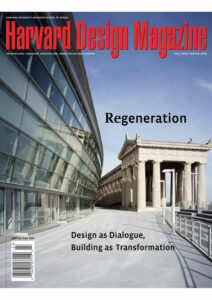Masked Nostalgia, Chic Regression: The “Critical” Reconstruction of Berlin
Redesign, for decades stigmatized by Modernist purists as an inferior architectural specialty reserved for the artistically timid and creatively challenged, has finally become a legitimate part of contemporary architectural practice: a look at the portfolios of today’s global architecture elite (for instance, Herzog & DeMeuron, OMA, Renzo Piano, Rafael Moneo, Norman Foster) and their unapologetic display of building additions, alterations, and adaptive reuse projects confirms that design strongly tied to an existing context—be it a single structure or an entire urban district—is no longer a cause for professional sheepishness. Benevolent observers have linked the new-found appreciation of redesign, of reusing the old or building upon it, to a growing awareness that the global environment, after centuries of abuse and reckless exploitation, is approaching the brink of collapse. And indeed, it would be astonishing if the three R’s that make up the ecological alphabet of the mainstream—reduce, reuse, recycle—hadn’t advanced into the discourse of contemporary design. Following this narrative, the act of rebuilding is viewed as the architect’s unselfish contribution to save Mother Earth. Not surprisingly, then, the architectural profession, eager as it is to regain an aura of social relevance, has endorsed this deliberate rebranding of redesign as sustainable practice, replacing the stale odor of historic preservation with a fresh breeze of environmental consciousness.1
As laudable as any initiative to minimize the environmental impact of building may be, the construal of redesign as a progressive strategy employed by enlightened architects is misleading. Henri Lefebvre has offered an alternative, perhaps more plausible reading of the current proliferation of redesign, viewing it as the logical conclusion to a cultural process that oscillates between destruction and reconstruction, an inevitable historic evolution driven by economic ambitions:
If advantage or profit is to be found in [doing] it, then the old is swept away. Later, however, [it will be discovered] how much such spaces may be pressed into the service of cultural consumption. . . . When this happens, everything that they had so merrily demolished during the belle époque is reconstituted at great expense. Where destruction has not been complete, “renovation” becomes the order of the day, or imitation, or replication. . . . [W]hat had been annihilated in the earlier frenzy of growth now becomes an object of adoration, and former objects of utility now pass for rare and precious works of art.2
Lefebvre’s Marxist analysis seems to describe quite cogently today’s ubiquitous urban redevelopment bonanzas converting ailing cities into gentrified entertainment zones, often exploiting the historic fabric as an indispensable backdrop to sell, at a profit, the myth of urbanity. But there is another, perhaps more powerful force at work, one rooted in a conscious political agenda transcending ecological necessities and economic aspirations. After all, the act of reusing a building or an urban ensemble, of relating one’s design to somebody else’s creation of the past, is an inherently conservative operation. The fundamentally reactionary nature of working within or upon what exists, an undertaking, one should remember, that ultimately salvages or even restores at least portions of the status quo (even if it is only the footprint of a predecessor), may be the very reason for redesign’s renaissance as an accepted and increasingly preferred architectural modus operandi: redesign as an act of political reassurance.3
It is important to distinguish the different strands of “rebuilding” embodied in the conceptual framework of redesign. On one end of the spectrum is the verbatim approach, the literal recreation of iconic or otherwise significant buildings of the past that fell victim to war, natural disasters, or ideological climate changes. On the other end is what I will call the dialectic method, the interpretative redesign of existing structures or their fragments as architectural or urban collages.
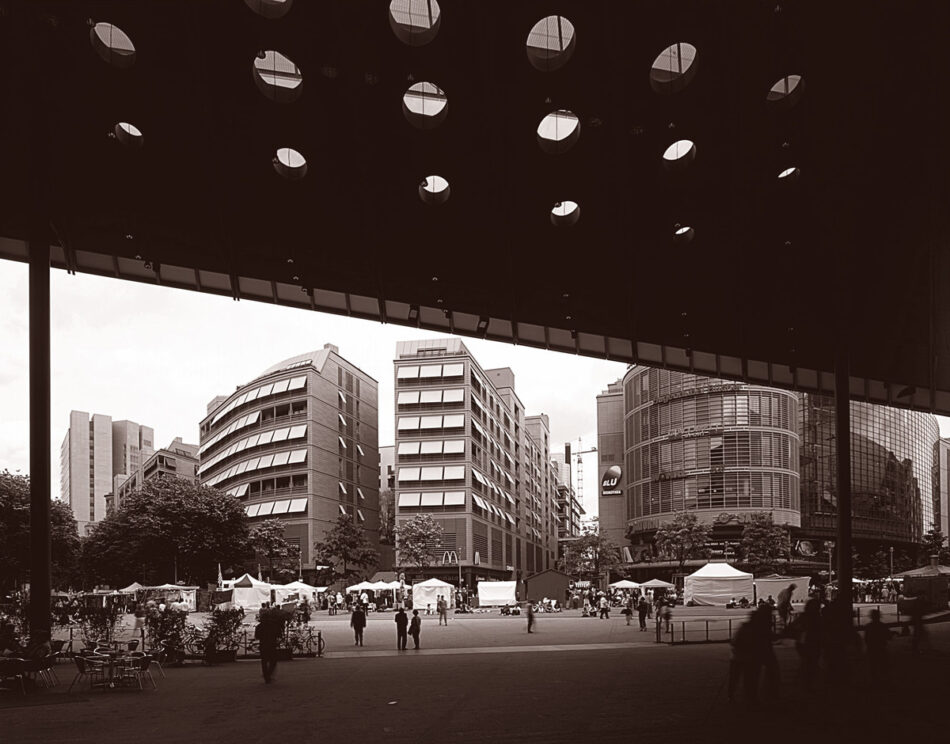
The exact restoration of the house in Wood’s Royal Crescent in Bath that had been destroyed by German bombs or the historically faithful rebuilding of Warsaw’s inner city exemplify the first, the verbatim strategy. In Bath and Warsaw, the link between literal rebuilding and the quest for political stability is quite apparent: here, verbatim reconstruction articulates a society’s refusal to accept the devastation forced upon it by a violent neighbor; it functions as collective therapy, based on a “moral legitimation for the victims to rebuild and thereby recuperate, physically and psychologically.”4 But its unambiguous restorative undertone, appropriate as it may be in specific cases, keeps literal redesign marginalized in today’s realm of academically sanctioned architecture, where it continues to be dismissed as artistically inauthentic copycat revisionism—“the saddest phenomenon of the development of our modern-day society unconsciously approaching a dead-end”5 in Wilfried Wang’s words—leaving no room for creativity.
The political subtext of dialectic redesign, on the other hand, is more elusive: its self-conscious, interpretative qualities facilitate a multitude of possible readings, thereby suggesting conceptual sophistication. The conversion of freight depots into universities, of warehouses into furniture stores, of horse stables into exhibition and conference centers:6 it is these kinds of projects—existing structures featuring inserted or overlaid new design elements, seemingly transcending the preconceived contradictions between past and present—that make it onto the covers of professional design magazines and into coffee table picture books, compelling us to believe in the possibilities of redesign “as a springboard for creativity, like a jazz musician who improvises around a central melody.”7 But as innocent as dialectic redesign, usually framed as an experimental collage of apparent opposites, may look through the lens of artistic integrity, it often carries an ideological ballast not unlike its verbatim counterpart, except that it conceals its particular message under the guise of stylistic diversity and architectural pluralism.
The new Berlin may be the world epicenter of this brand of dialectic redesign. The rebuilding of the city—not the immediate postwar slash-and-burn urbanism of misguided bureaucrats and traffic engineers on both sides of the Wall all seeking to exorcise the ghosts of Germany’s past, but the post-Wall Critical Reconstruction, whose interpretative redesign formulas were originally tested in West Berlin’s International Building Exhibition, or IBA, in the mid 1980s—exemplifies, on a large scale, the stealth conservatism that frequently lies behind the thick layers of celebrated, avant-garde-approved redesign, revealing a recuperative agenda strikingly similar to the ideological transparency of historic preservation. As it turns out, the exact reconstruction of Warsaw and the more experimental operations in Berlin have more in common than their formal differences might suggest: both reflect politically charged searches for national or societal identities in transitional times. More generally, the worldwide emergence of dialectic redesign may be viewed as a form of resistance to the perceived homogenizing forces of rampant globalization. Dialectic redesign allows a “global city” to participate in the vanity fair of avant-garde architecture to attract transnational capital, while simultaneously protecting—or recreating—a familiar physical framework in which regional differences and local idiosyncrasies can crystallize.8
Berlin’s restorative redesign approach was first codified in the 1970s under the umbrella of Critical Reconstruction, introduced by the Berlin architect Josef Paul Kleihues and his intellectual alter ego, Dieter Hoffmann-Axthelm, who argued that Berlin did not have to be built ex novo—that the city did not need to, and in fact should not, be reinvented. Instead, Critical Reconstruction offered a dialectic, interpretative rebuilding philosophy, promising to restore the historic urban tissue that had been seriously damaged by Albert Speer’s megalomania, Allied carpet bombings, and decades of functionalist postwar planning.9 In order to illustrate the “better urbanism” that Critical Reconstruction was promoting, Kleihues and his disciples skillfully employed the romantic imagery of black-and-white postcards depicting scenes of petit-bourgeois Gemütlichkeit and the bustling streets in Berlin’s Roaring Twenties — an imagery, one should add, that conveniently omitted marching Nazi hordes, overcrowded housing projects in dire hygienic conditions, and unemployed men waiting in line at the soup kitchen.10 The Kleihuesian rhetoric found fertile grounds in a country suffering from the aftermath of the 1968 clashes between the bourgeois status quo proudly celebrating West Germany’s miraculous economic postwar recovery and a younger generation demanding a societal ethos that would transcend capitalism’s materialism.11 In this context of political chaos, lingering national insecurities, and heightened political anxiety, Critical Reconstruction and its emphatic rejection of a utopian future promised to reestablish a cohesive physical framework, an urbanism of typological harmony as a backdrop for social stability.
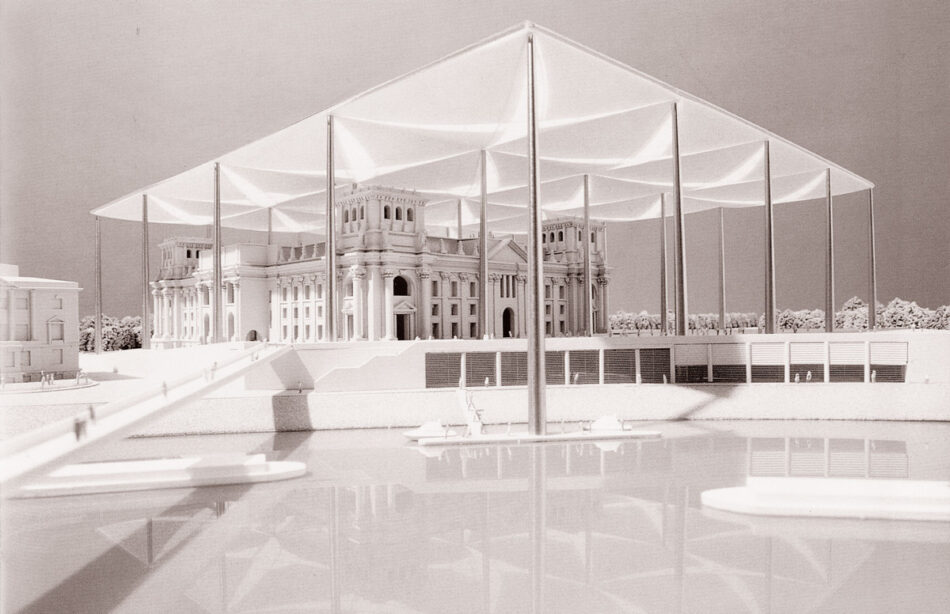
Kleihues was appointed director for the IBA in 1979 and organized the multiyear building program using a two-tiered strategy: IBA Alt was pursuing “sensitive urban renewal,” dealing with the preservation, renovation, and reuse of the existing aging housing stock, while IBA Neu was the laboratory for Critical Reconstruction, proposing new buildings as a means to mend the holes in Berlin’s ragged urban fabric. Kleihues claimed that “the culture of the European city, whatever development it may take, cannot afford to waive the methodological organization of its urban design based on certain, binding goals,”12 and he instructed all IBA architects to “pick up historical traces, respect the traditional layout, and conserve existing buildings.”13 Emphasizing the importance of architectural coherence for a successful reurbanization of Berlin’s old neighborhoods, Kleihues crafted a catalogue of design guidelines mainly based on the typology and stereometry of the traditional urban block: historic street patterns were reestablished; new infill structures, limited in height to roughly seventy-five feet, had to suture the block tissue and reestablish a legible street edge; and new blocks were divided into small parcels to prevent the construction of megastructures viewed as incompatible with the traditional European urban grain.14
Kleihues vehemently denied that he was driven by nostalgia,15 and in a conscious effort to frame the IBA as a progressive event, he secured the design services of the world’s traveling architectural nobility, arguing that the involvement of a variety of architects in the design of the IBA’s individual buildings was paramount to ensure an urbanism of aesthetic diversity. Of course, the ideological straightjacket of Critical Regionalism served as a safeguard against possible architectural escapades; in retrospect, it is clear that Kleihues intentionally misconstrued diversity as a game of harmless facadism.16 Nevertheless, his clever promise of stylistic plurality thoroughly embedded in an arguably reactionary urban redesign agenda guaranteed the IBA broad political support as well as the endorsement of the design professions, making it a resounding international success, a formidable architectural spectacle that Time called “the most ambitious showcase of world architecture in this generation.”17 More importantly, the inclusion of an armada of international starchitects, quietly surrendering their respective architectural egos to the Kleihuesian design dogmas, established a reciprocal dependency between design celebrity and design control that has defined the following two decades of Berlin’s reconstruction.
The IBA officially closed in 1987, but the instrumental repertoire of Critical Reconstruction proved even more opportune when the Berlin Wall fell two years later. The sudden reunification of Germany caused a national identity crisis of unprecedented proportions: two unequal halves with opposite political and economic systems had to merge quickly into a democratic whole, a confident new nation carefully avoiding echoes of old German nationalism. Facing the “impossible task of reconciling the parochial and the cosmopolitan, expressions of pride and humility, the demand to look forward and the appeal to never forget,”18 Berlin’s physical reincarnation as Germany’s political epicenter needed to be an unequivocal symbol of the country’s newfound national unity.
Sociologist Anthony D. Smith has argued that to create a nation, “it is not enough simply to mobilize compatriots. They must be taught who they are, where they came from, and whither they are going”19 History, tradition, and heritage—loaded terms that had been for decades all but avoided in the public discourse of postwar Germany—were consequently given new currency to invoke the mutual roots of a divided society. Not surprisingly, Berlin’s historic building stock and urban fabric, undeniable reminders of a common past, served as the genetic pool for the new capital’s rebirth, while Critical Reconstruction, now shorthand for architectural and urban convention, coherence, and continuity, became its conceptual midwife. What had originally been conceived as an urban design initiative swiftly transformed, with Kleihues’s blessings, into a rigid set of architectural imperatives enforced by Berlin’s post-Wall city planning director, Hans Stimmann, who explicitly sought to resuscitate Berlin’s elusive genius loci and to rebuild a city unified by “Prussian classical order and by streets lined with masonry buildings”20—a capital city on a par with the physical grandeur of its European counterparts. In dangerous semantic proximity to the Nazi notion of Entartete Kunst (degenerate art), Stimmann, a Social Democrat, advocated the methodical exclusion of aesthetic otherness, insisting that only a uniform architectural canon could appropriately represent political unity.21
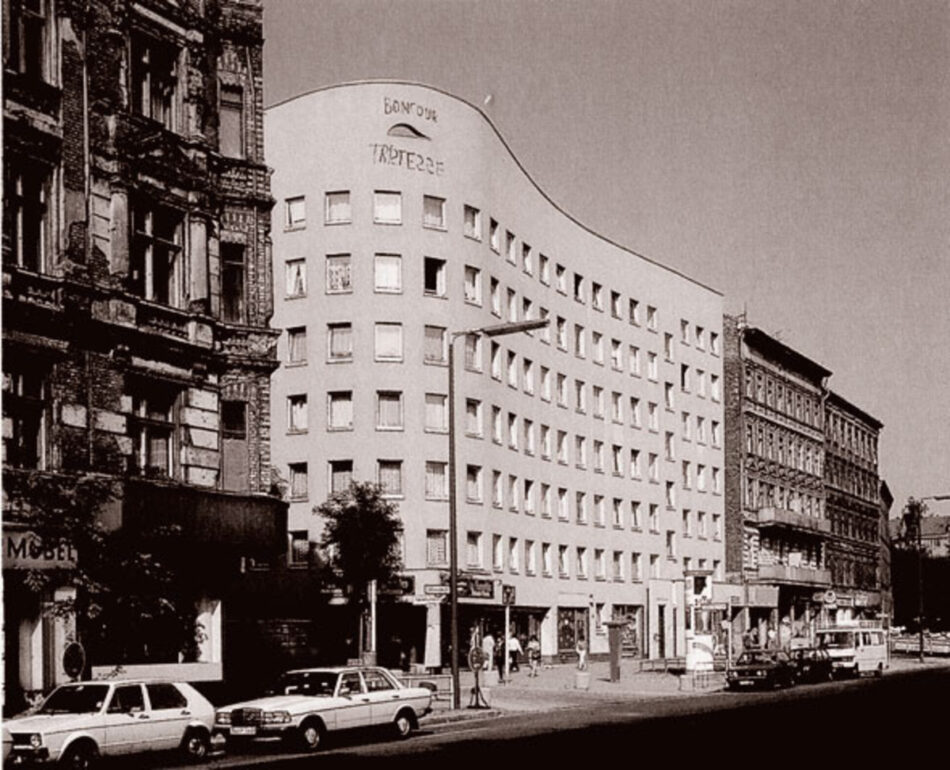
In addition, Berlin had clear ambitions to create a representational environment worthy of the capital of Europe’s most populous country, as well as to provide a certain level of monumentality arguably difficult to achieve in the language of Modernism and perhaps inappropriate for a democratic government. The dialectic redesign of existing government buildings, most of which had been commissioned by previous authoritarian or totalitarian regimes, provided a solution for this dilemma, removing the structures’ often undesirable historical stains in the laundromat of Critical Reconstruction without bleaching their architectural intelligibility as metaphors of power.22
It speaks volumes that today’s undisputed symbol of Berlin’s post-Wall renaissance is Norman Foster’s Reichstag project, a posterchild of politically motivated adaptive reuse, whose genesis was based on the assumption that new design elements can sanitize and purify historically burdened places, or, more broadly, that a critical reappraisal of the past legitimizes the selective reappropriation of certain aspects of history while omitting others. Initially, when the decision was made to move Germany’s federal government back to Berlin, it seemed improper to locate the parliament of the newly reunified country within the confines of the original Reichstag, a Wilhelmian colossus of questionable architectural merit that was erected by the German emperor for a pseudo-Democratic parliament and abandoned as soon as he had to abdicate in 1918. But a vocal alliance of local preservationists and conservative members of parliament lobbied for the reuse and historically faithful reconstruction of the Reichstag, which had been targeted by Nazi arsons and then severely damaged during the Second World War before it was rebuilt in the 1950s without its signature glass and steel dome. Eventually, a broad consensus was reached that the building should indeed be rehabilitated, yet the structure’s blatant monumentality and its political past were widely perceived as detrimental to the image of a modern society and enlightened democracy that Germany was eager promote. To legitimize the conservation of a building associated with Germany’s dark history, the building’s redesign needed to be internationalized and avant-gardeized.23
It was perhaps not entirely coincidental that a British star designer with an impeccable record of innovation emerged as the winner of the global Reichstag design competition, immediately putting to rest any concerns that this project could be the harbinger of German neo-nationalistic ambitions. Ironically, Foster, who had won the competition with his design for an enormous flat roof floating above the old Reichstag, half of which was to be buried under a gigantic berm—a radical design that would have intentionally miniaturized the existing structure—ended up designing what the conservative protagonists in the debate had demanded all along: a new assembly hall within the restored historic Reichstag shell, topped by a glass and steel dome—albeit a modernized version, an accessible high-tech cupola with sustainable features.
Foster has been somewhat hesitant to embrace his own creation, perhaps aware that he was ultimately used to lend credibility to the preservation of a building for which he had publicly expressed nothing but genuine distaste;24 after all, the architect had originally intended to dominate the troublesome old with the untainted new, whereas the final design clearly reversed this hierarchy and demoted the new design components to clever high-tech gadgets putting a modern spin on an old building. For Berlin, however, the strategy clearly worked: it saved a landmark with a troublesome background while simultaneously securing an authentic “Foster” for the city’s architectural trophy case, an iconographically powerful tourist attraction whose main draw may be the building’s brandname re-creator as much as its architecture per se.
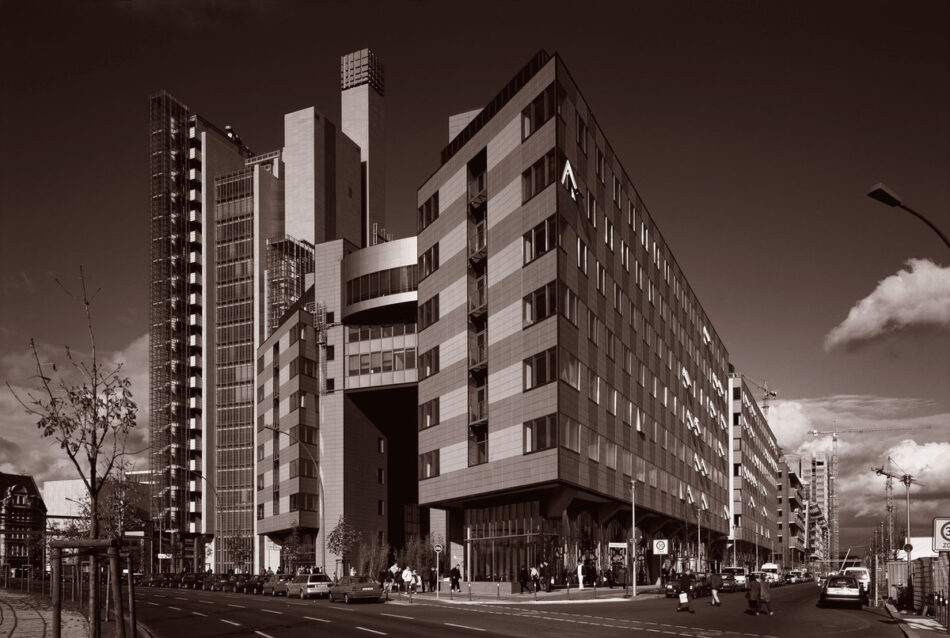
Foster’s central role in the ideological reprogramming of the Reichstag and its metamorphosis from stained monument to cheerful emblem of democracy epitomizes the token avant-gardism that has been an indispensable part of Berlin’s redesign efforts since the IBA years. The members of the global architectural jetset invited to work in Berlin sometimes questioned Stimmann’s catechism of architectural correctness, but they usually played by the rules, often aligning their own rhetoric with the official vocabulary of Critical Reconstruction. Accordingly, Renzo Piano insisted that his Potsdamer Platz project was “not a new city—this is the old,” and that his “goal was to recapture . . . the area’s history.”25 Even Rem Koolhaas, not exactly a conformist, positioned his design for the Dutch Embassy in Berlin, a geometrically disciplined cube redefining the street edge, within the larger trajectory of Critical Reconstruction, declaring that “every move through (the building) reveals Berlin’s history.”26
But is it really possible to reconcile a city’s conservative and somewhat xenophobic mission of finding its shattered identity in tradition and a mystical genius loci with its aspiration to become a “global city” boasting breathtaking, internationally celebrated architectural wonders?27 In Berlin, the slightly schizophrenic premise of dialectic redesign to bridge the gap between tradition and progress has arguably led to questionable results: the city’s reconstruction, while a marvel in its sheer magnitude, is generally deemed dull and uninspired: Richard Rogers, Arata Isozaki, Rafael Moneo, Philip Johnson, I. M. Pei, Giorgio Grassi, and ironically, even Aldo Rossi all came to rebuild Berlin and left with some of their most forgettable work.28
But it is Frank Gehry’s strange DG Bank Headquarters project at Pariser Platz that communicates most clearly the inherent contradictions in Critical Reconstruction. Forced to work within the traditional typology of the vacant, re-parcellized block facing the Brandenburg Gate and to fill up the entire footprint of the site, Gehry designed a tame five-story stone-clad facade shielding an amebic steel structure floating inside the block. Instead of a Guggenheimian attraction, Berlin got Gehry-in-a-box, an architectural Trojan Horse dutifully redefining the southern edge of the historically restored urban square.
While the aesthetic shortcomings of Berlin’s recipe for dialectic redesign are evident, it may be more difficult to evaluate its political efficacy—does the recreation of spatial familiarity indeed promote societal stability or national unity? Interestingly, Critical Reconstruction has become less and less critical in recent years, perhaps demonstrating that the intended political message was not getting through the conceptual veil of dialectic redesign. Berlin will not become another Warsaw, but the current planning for the literal reconstruction of vanished landmarks like the Royal Palace or Schinkel’s Bauakademie seem to mark a gradual shift to a politically more explicit brand of redesign—verbatim rebuilding.
Reuse, is perhaps most successful (and least suspect of political conservatism or glorified historic preservation) in projects that use buildings without iconographic power or monumentality; two examples of different scales are Will Bruder’s Phoenix Library, using an obsolete movie theater that could as well have been razed, or Steven Holl’s Storefront for Architecture.
4 Steven Whiting, “(Re)constructing Berlin: Architects and Academics Consider the Once and Future Capital,” Journal of the International Institute (Fall 2000): 8–9, 24. 5 Wilfried Wang, “Rekonstruktion als Ersatz,” Archithese 2 (1998): 16–18. 6 These three examples are actual projects featured in the July 2003 issue of Architectural Record dedicated to adaptive reuse projects. 7 Deborah Snoonian: “Beyond Bricolage,” Architectural Record (July 2003): 135. 8 The ubiquitous redesign of old train stations or factories into museums or shopping centers preserves landmark buildings with a strong local presence, reprogramming them into symbols of the postindustrial urban age; high design examples are the Tate Modern in London and the Küppersmühle in Duisburg (both by Herzog & de Meuron), the Hamburger Bahnhof in Berlin (by Josef Paul Kleihues), or the Musée d’Orsay in Paris (by Gaetana Aulenti). 9 The emergence of Critical Reconstruction coincided with an intense discourse about the future direction of European architecture and urbanism in the early 1970s—a time when the catchword “Americanization” captured all the negative associations now embodied in the notions of globalization and cultural homogenization. The question arose whether the reformulation of a genuinely European urbanism could stem the perceived loss of urban authenticity. Aldo Rossi had entered this debate early on and positioned himself as its most prolific theorist, focusing on typology as an instrument for securing urban continuity and preserving the role of the city as the repository of what he called the “collective memory of man.” Not surprisingly, Kleihues’s own writings about “Critical Reconstruction” echo many of Rossi’s earlier arguments and also incorporate ideas of Colin Rowe and Leon Krier, the latter of whom had worked in Kleihues’s office in the early 1970s. (One of Kleihues’s articles was entitled “Städtebau ist Erinnerung” [Urban Design is Memory]; it appeared in “Internationale Bauaustellung Berlin 1984 / 87,” Die Neubaugebiete [Berlin: Bauausstellung Berlin GmbH, 1993], 14–29). In fact, the politically savvy Kleihues was not an original thinker; his texts, lacking both the brilliance and intellectual depth of Rossi’s work as well as the sharp rhetoric of Krier’s articles, were arguably the pulp version of the academy’s complex and thickly layered treatises about European urbanism. Kleihues’s real achievement, then, was his ability to escape the prison of pure academicism by translating his colleagues’ thoughts into tangible policies. For an excellent account of the functionalist reconstruction of postwar Berlin, see Wolfgang Schäche, “Der Hauptstadtwettbewerb 1957 /58: Entwürfe gegen die Vergangenheit” and Dorothea Tscheschner, “Sechzehn Grundsätze des Städtebaus und die Charta von Athen,” both in Thorsten Scheer et al., eds., Stadt der Architektur, Architektur der Stadt (Berlin: Nicolaische Verlagsbuchhandlung, 2000). 10 Brian Ladd makes a similar point in his book The Ghosts of Berlin: Confronting German History in the Urban Landscape (Chicago: University of Chicago Press, 1997), 230. The first and perhaps most notorious picture book photographically whitewashing the old city and comparing its supposed urbanistic superiority to the deficient new is Wolf Jobst Siedler’s Die gemordete Stadt (The Assassinated City) (Berlin: Herbig, 1964). 11 For an excellent history of the societal frictions in late 1960s Germany, see Ingrid Gilcher-Holtey, Die 68er Bewegung (Munich: C. H. Beck, 2001). 12 Josef Paul Kleihues, “Die Gebiete des Stadtneubaubereichs” in Internationale Bauausstellung Berlin, Projektübersicht (Berlin: Bauausstellung Berlin GmbH, 1987), 6. 13 See Kurt Anderson, “Rebuilding Berlin—Yet Again,” Time, June 15, 1987, 66–69. 14 See Gert Kähler, “Als der Dampf sich nun erhob . . . ” in Thorsten Scheer et al., 381–387. 15 Kleihues condemned literal reconstruction as “increasingly nostalgic” (Kleihues [1987], 5). Clearly aware that any nostalgic or sentimental undertone could derail the broad coalition of Berlin politicians and international architectural stars in support of Critical Reconstruction, Kleihues was eager to position his agenda within the larger trajectory of Modernism itself, alluding to Thoeodor Adorno’s Critical Theory and to Modernism’s “enlightened dialectic” as the ideological backbones of Critical Reconstruction (see Kleihues [1987], 6.). In another article, he explains that “critique, finally, implies the claim of modernity to possess an awareness of crisis while retaining a positive attitude to life.” But he immediately warns: “The temptation is great to escape from an awareness of crisis into the prefect world of a . . . historical order or, in the course of a fanatical pursuit of new creations, to succumb to what Nietzsche called a frenzy of originality” (“From the Destruction to the Critical Reconstruction of the City: Urban Design in Berlin after 1945” in Josef Paul Kleihues and Christina Rathgeber, eds., Berlin-New York: Like and Unlike [New York: Rizzoli, 1993], 407.) 16 In a 1999 interview for the film documentary Berlin Babylon by Hubertus Siegel, Kleihues commented: “When you let architects lose, when you don’t put them on a leash, they create the biggest nonsense. That’s been proven over the years.” The transcript, entitled “Gespräche ohne Kamera, Teil 6,” is online at http://www.berlinbabylon.de/Media.Sumo/Kleihues.pdf. 17 Anderson, 66. 18 Ladd, 235. 19 Anthony D. Smith, “Towards a Global Culture?” in D. Held and A. McGrew, eds., The Global Transformation Reader (Cambridge: Polity Press, 2000), 244. 20 Quoted in Ladd, 232. 21 One of Stimmann’s most outspoken critics was Daniel Libeskind, who declared that “Stimmann’s approach simply erases the last fifty years of Berlin’s history. He seeks a more carefree age” (quoted in Ladd, 233). He publicly accused Stimmann of “reactionary tendencies” and claimed that Critical Reconstruction was based on a “dogmatic and anti-democratic image of society,” encouraging “unimaginative regurgitations of bureaucratic formulas.” (Quoted in Kähler, 384). 22 Except for the new chancellery (Axel Schultes’s strange collage of Louis Kahn’s late work, monumental in its own right), all major branches of government have moved into redesigned old buildings, most often under the pretense of fiscal responsibility. 23 According to Gerwin Zohlen, Foster once described the Reichstag as a building that “nourished the forces destroying democracy.” But Zohlen argues that the Reichstag has been linked mistakenly to Nazism; in fact, after seizing power, Hitler moved the Nazi-controlled pseudo-parliament to another facility, and his henchmen set the building, then viewed as a symbol of democracy, on fire. See Gerwin Zohlen, Auf der Suche nach der verlorenen Stadt (Berlin: Nicolaische Verlagsbuchhandlung, 2002), 88–92. 24 See Norman Foster, Der Neue Reichstag (Leipzig-Mannheim: F.A. Brockhaus, 2000). The apologetic undertones throughout Foster’s book make sufficiently clear that the final design of the Reichstag was a big compromise of his original vision. See also Zohlen, 89. 25 Quoted in Leon Krempel, Berlin Architektur 2000 (Petersberg: M. Imhof, 2001), 16. For a detailed account of the competition for the redesign of Potsdamer Platz and its buildings, see Vittorio Magnago Lampugnani and Romana Schneider, eds., Ein Stück Grossstadt als Experiment (Stuttgart: Gerd Hatje, 1994). 26 Quoted in Samira Chandwani, “Koolhaas Speaks On ‘Global’ Style,” Cornell Daily Sun, April 26, 2005, http://www.cornellsun.com/vnews/display.v/ART/2005/04/26/426ddebcc1992. 27 The rejection of other urban models from around the world played an important role in the discourse about Berlin’s reconstruction, perhaps due to the difficulty of defining precisely Berlin’s genius loci. The villain most often mentioned was the “American City,” portrayed as the antithesis to Berlin’s traditional urbanism. Hilmer und Sattler, the architects who won the original design competition for the Potsdamer Platz masterplan, underscored that their scheme was based on the rejection of the “American urban model of high-rise conglomerates” (quoted in Zohlen, 55). And in a 1999 speech at the Los Angeles World Affairs Council, Mayor Eberhard Diepgen emphasized, without giving any specific details, that Berlin’s was pursuing an urbanism quite different from the prototypical emerging megacities around the world: “Our goal is to find one view of the city, not the same as Shanghai or Abu Dhabi, but very typical of Berlin” (http://www.lawac.org/speech/diepgen99.html). Finally, Kleihues reminded his international colleagues working in Berlin that they were expected to assimilate: “To build in Prussia, you have to behave like a Prussian” (quoted in Berlin Babylon, http://www.berlinbabylon.de/Media.Sumo/Kleihues.pdf). 28 A casual survey of international design magazines seems to support this assessment: Berlin’s postwall redesign has drawn an enormous amount of professional attention, but in general, architecture critics have been hesitant to embrace the actual architecture of the New Berlin. In response, a somewhat defensive Ulrich Schwarz argues that “the ‘artificial media bang’ . . . is not a quality to which current German architecture aspires” (in Ulrich Schwarz, ed., New German Architecture: A Reflexive Modernism [Ostfildern-Ruit: Hatje Cantz, 2002], 13). Two noticeable exceptions are Daniel Libeskind’s Jewish Museum and Sauerbruch and Hutton’s GSW Headquarters, darlings of the professional press clearly defying the dogmas of Critical Reconstruction.